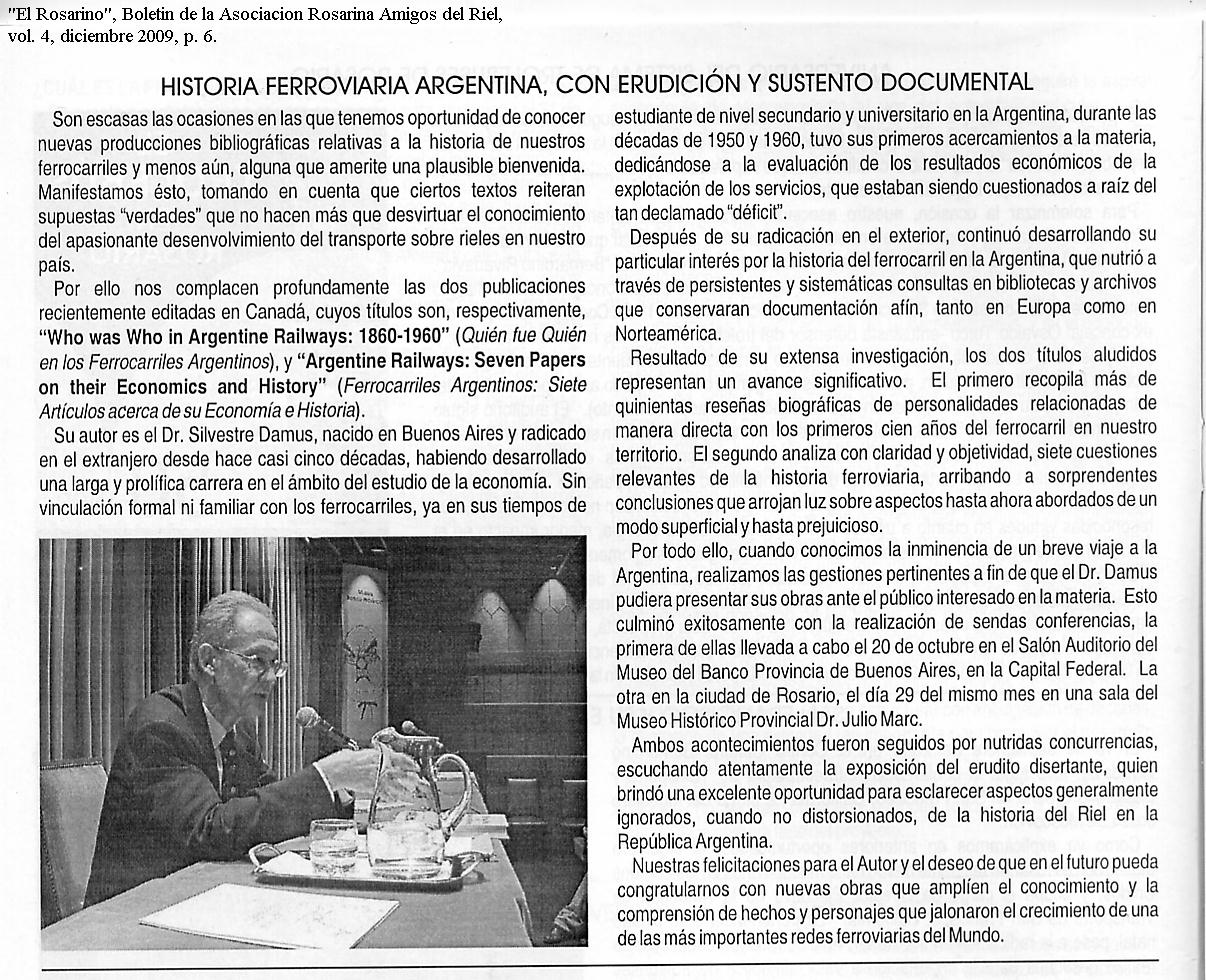BOOK REVIEWS
Who was Who in Argentine Railways, 1860-1960, 2nd ed.:
From the authoritative reviewer of the second edition:
‘The work that produced this massive and authoritative tome must have been prodigious, but well worth it: here we have a good candidate for a 'Desert Island' book, hundreds of pages and something new or unusual on every one of them.’
Who was Who in Argentine Railways, 1860-1960, 1st ed.:
I want to draw your attention to the recent publication (2009) of a book
entitled "Who was who in Argentine Railways, 1860-1960", DIA Agency,
Ottawa, by Sylvester Damus. It is an incredibly acribic and complete
mine of information about the many people, mostly of British origin,
that for a century were engaged in planning, constructing and running
the railways of the Argentine Republic. I make it that the book in its
474 pages, contains more than 650 biographies, as well as additional
information. The tome is naturally an absolute must for railway
historians, but genealogists too are sure to find much interesting
data in it, since Damus has made an effort about tracking down parents,
wives and offspring of the biographed. I myself, an Argentine camp
(spanglish for larger tracts of land) hobby-historian, have found the
book is rich in land ownership relevant data. Looking, for example,
into the succesion of proprietors of a camp next to Woodgate station,
F.C.C.A., now Monte Buey village, Córdoba province -where I grew up-
I find that the "Who was who" treats several of them: Henry Russel Shaw,
Henry Hammond Woodgate (and his father Frederick Christopher Woodgate,
who actually lent his name to the station) and Henry Herbert Loveday,
all naturally connected with the Central Argentine Railway Co.
Sylvester Damus' book is certainly much more worth than the 79 US
dollars + postage it costs. You can order it through your bookshop,
ISBN number 978-0-9811096-0-2, or through dia@storm.ca . I very
much hope that a new edition will be necessary sometime with yet more
biographies, and perhaps, brief life-summaries of the confusingly
many Anglo- (and Franco- and State-) Argentine Railway companies.Enjoy Sylvester's book!
Yours sincerely, Juan Delius
news.rootsweb.com/th/read/SOUTH-AM-EMI/2009.../1240919573, Tue., 28 Apr 2009.And from New Zealand by a reader of the first edition :
An extensive and informative publication of the life and times of Argentina 1860-1960. It does not only refer to the railways but to the development of that country with a listing of nearly 500 profiles of mainly British settlers.

ARGENTINE RAILWAYS, seven papers on their economics and history by Sylvester Damus.
186pp. 11in x 8½in. Hardback with coloured cover. ISBN 978-1-926582-00-9. DIA Agency, Inc.
Ottawa, Ontario, Canada, US$49.00 plus postage.In the house of railway history, there are many mansions. One, maybe even a wing in its own right, is
academic history. This work lies at the solid, traditional end of the wing, dealing in hard facts and data –
no post-modern pretensions and jargon here. Dr Damus offers seven distinct essays, mostly taking on
aspects of the unexamined ‘received wisdom’ about the once-massive, and often British-owned, railway
system of Argentina, now much faded.He suggests that the productivity of Argentina’s railways was not bad, better than that of the economy
as a whole, although comparisons with similar economies might throw interesting
light on this issue. He finds no evidence of sinister interlocking directorates,
whereby British-owned railways conspired to buy supplies and machinery from
allied British owned firms, similarly that railway directors used their lines to serve
and enhance their landholdings. He also analyses the ‘Mitre Law’ (named after
Emilio Mitre) of 1907, designed as a fundamental railway statute, which seemed
sensible enough in its day, but gradually became dysfunctional under changing
conditions, a not unfamiliar problem with railway legislation in our own country.There are some helpful appendices, one for example, that clears up the often
misunderstood issue of ‘guaranteed dividends’ – which turned out to be nothing of
the sort. Much of the book is couched in closely-argued language which assumes some basic
understanding of economics. But, many of the passages, for example on the technical progressiveness of
the Argentine railways (fairly quick off the mark with compounds and superheaters, or diesel traction
for example) or the personalities involved will be of interest to the general railwayists. Here we find
Alexander Henderson, a major railway stockbroker and chairman of the GCR, for example; also Sir Sam
Fay, once GM of the GCR (not the GER, in one of the few slips in this carefully-written work) and later a
director of the Buenos Aires Great Southern Railway, and chairman of Beyer Peacock.Footnotes are where they ought to be, at the bottom of pages; references are numerous and evidence of
wide reading. A pity there is no index, but that hardly detracts from the thought-provoking arguments that
frame the text.R.A.S. Hennessey
in SLS Journal, The Journal of the Stephenson Locomotive Society, No. 861, Volume 86, January/February 2010,
page 39.Despite their importance, much is still unknown about the operation and development of railways, especially outside of North America and Europe. Sylvester Damus fills a number of gaps by analyzing Argentine railways.
. . . . . . . . . . . . . . . . . . .
Overall, Damus refutes a number of hypotheses and offers some alternative explanations related to the performance of Argentine railways. The use of quantitative evidence is refreshing and the arguments are generally convincing. It should serve as the basis for quantitative economic histories of Argentine railways in the twentieth century.
Dan Bogart (University of California, Irvine),
in The Journal of Economic History, vol. 70, No. 4, December 2010, pages 1010-1011.